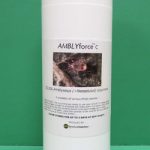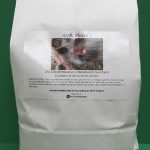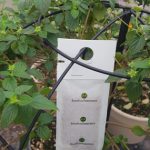Description

Amblyseius (=Neoseiulus) cucumeris, the thrips predatory mite, are useful for the prevention, control, and management of various thrips species. A. cucumeris are tough, flexible predators that happen to prefer thrips, mostly the immature thrips stages. These predators are supplied two different ways: a bulk product in vermiculite for fast distribution and consumption; and a sachet product for slow preventive releases over an 5-7 week period (depending on greenhouse conditions). Some of the species they can devour include: the western flower thrips (Frankliniella occidentalis); the flower thrips or eastern flower thrips (F. tritici); the onion thrips (Thrips tabaci); the greenhouse thrips (Heliothrips haemorrhoidalis); and possibly the melon thrips (Thrips palmi), too. Other pests which can be impacted by these predators include cyclamen mites (Phtyodromus =Steneotarsonemus pallidus), broad mites (Polyphagotarsenomus =Hemitarsonemus latus) and, to a slight degree, tomato russet mite (Aculops lycopersici). And, as an Amblyseius spp., these predators may eat other pests as well.
Life-style
Benefits
These mites are very, very economical. So economical, in fact, some growers are using A. cucumeris as they would a pesticide: the infamous repeated dousing technique. Speaking of pesticides, these predators are compatible with many; a real plus in an Integrated Pest Management (IPM) program. Lastly, this is the only commercially produced A. cucumeris in the US. Any other A. cucumeris product will have spent days traveling from Canada or Europe.
Drawbacks
Scouting
- Use blue or yellow sticky traps to capture adults which can be counted weekly and/or;
- Use the “paper method” by gently shaking the plant over a white piece of paper on which they’ll show up nicely.
Try the latter on a corn plant this summer, tap out the tassels if you really want to see some thrips. Unless your scouting is really top-notch, you’ll probably miss most of the predators present on the leaves. However, if you see some agile-looking mites running a zigzag quickly across the leaf’s undersurface, they are probably predators.
Advisories
There may be a compatibility issue when used with Phytoseiulus persimilis. Used together, these pairs are under suspicion: the A. cucumeris may eat the other predators’ eggs. Before getting some loose bran product, determine how it’s going to be applied so that you can prepare. Beside shaking out the bulk bran onto the leaves, you may wish to apply it with a broadcast granule or whirlybird type spreader.
Another compatibility issue may exist with Dalotia coriaria. If used together, we strongly suggest using the A. cucumeris sachets instead of the bulk bottles.
Usages
Release Rates for AMBLYforce™ C
| Classification | Release Information |
|---|---|
| Bottle or Bulk Bag | 5-10 per sq. ft, repeat weekly or bi-weekly as needed. |
| Slow release sachets | 1 sachet per 10 sq. ft. but may be increased to one sachet per plant in some crops. |
| Alert: | Release rate suggestions on these pages are usually not sufficient for cannabis growers. For cannabis release rates check out our Cannabis page or contact us with questions. 1 (800) 477 3715. |
Produced in the USA by Beneficial Insectary!
Purchase
-

AMBLYforce™ C – thrips predator (20,000/ 50,000/ 250,000 in liter tube)
$15.95 – $128.95 Buy Now -

AMBLYforce™ C – thrips predator (5 liter bulk bag)
$55.95 – $128.95 Buy Now -

AMBLYforce™ C – thrips predator in slow release sachets
$28.95 – $229.95 Buy Now -

Universal Release Boxes- Pack of 50
$28.95 Buy Now
